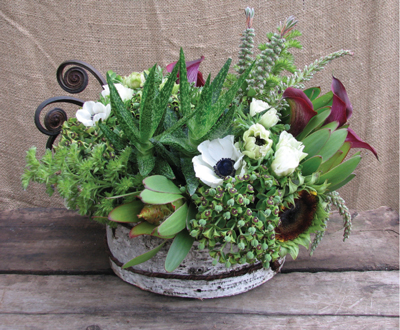Packed into vertical planters, demure wall hangings and antique frames, succulents create living pieces of art with the texture and colors of fall.
Local florists and designers, including Peggy O’Neill, owner of Tiburon’s Hearts and Flowers, say this season is all about texture. Some of her favorite items for lasting centerpieces include succulents, pincushion protea, Japanese maple leaves, baby purple artichokes, persimmons, pomegranates and decorative kale. She calls her living works of art, which she sometimes infuses with kitchen herbs, culinary centerpieces.
At sustainable florist and nursery Local Flora, owner Silke Von Bauer says arrangements made with succulents are long-living, making them an ideal centerpiece (1). Her San Anselmo shop has stocked work by Trish Ottens, a Fairfax designer who creates living art pieces, like the “Parlor Dance” piece (2). Her creations require bright but indirect sunlight and can be brought indoors to decorate a space for an event. Parlor Dance by Trish Ottens Designs 415.225.9999, trishottensdesigns.com and long-lasting centerpiece from Local Flora (San Anselmo), 415.459.4490, marinflora.com
A living succulent wreath (3) can be maintained by watering weekly, and simple hanging vases (4) can dramatically transform a dining room setting. Flora Grubb Gardens (SF), 415.648.2670, floragrubb.com
Bardessono's Living Art Wall
Vertical walls of plants aren’t only aesthetically pleasing; they’re also eco-friendly, requiring less water than traditional gardens. Thanks to an article in the New York Times, the tillandsia wall at Bardessono Hotel in Yountville is becoming one of the area’s best-known living works of art.
Garden designer Flora Grubb, builder Kevin Smith and architect Seth Boor brought the project to life. One of the first ideas for the space was a vertical garden, but Grubb assessed the area and discovered there wasn’t any drainage. Instead, the idea of a tillandsia wall was decided on, and the team filled four alcoves in the hotel with the distinctive design. The roots of the tillandsia grow in the air rather in the soil, and upkeep consists of a simple twice weekly misting with a half gallon of water. Boor came up with the concept of clipping the tillandsia to metal rods that would protrude from the wall, which allowed for an easy switch-out if a specific plant wasn’t up to par, and each plant was clipped with enough space separating it from its neighbors to highlight the unique growing patterns.


